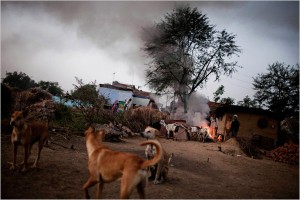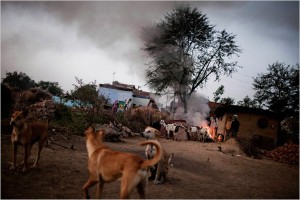A recent NYTimes article titled “Third-World Stove Soot Is Target in Climate Fight” calls out the third world as a major contributor to global warming. After I spent a while researching the topic, I found this article very frustrating and misleading.
Black carbon – or soot – is produced from a variety of sources. The stoves used by billions to eat and stay warm in underdeveloped nations produce soot since they are very low tech and inefficient. Soot is also produced from gasoline engines and a variety of other sources – a fact the article doesn’t mention. Soot can travel in the atmosphere and land on snow, reducing the albedo (how reflective a surface is) of the snow. This means that the earth gets warmer because the black on the snow doesn’t reflect as much of the sun’s rays as white snow.
Black carbon, however, is not currently accepted by the scientific community as a large contributor to climate change. The IPCC (Intergovernmental Panel on Climate Change), in their 2007 report, mentions soot and black carbon dozens of times but believed that aerosols like soot are too understudied and variable to make sweeping claims. Aerosols, as a category, are actually believed to have a net cooling of the planet since they block and reflect solar radiation before it enters the earth’s lower atmosphere. The blackening of snow is explicitly cited as a minor source of warming.

Ultimately, the question is not whether soot has an impact or not. The question is: How much of an impact does soot have on climate change? The jury is still out for now. The scientific community has yet to reach any consensus on how important soot is. If soot is as important as Dr. Ramanathan claims, then the NYTimes article should tweak a few things in this article and mention that just as much soot comes from automobiles as from the small stoves in the third world – a statement Ramanathan makes very clear in his article.
Reasons this NYTimes article isn’t up to par:
- This article unnecessarily undercuts the efforts of the IPCC creating confusion about the facts of climate change.
- This article insinuates that people in the 3rd world are to blame for climate change. Billions of people would love the opportunity to drive polluting vehicles around wealthy urban centers to grab some fast food instead of hunching over a smokey stove to eat and stay warm.
- This article muddies the entire climate change issue with the discussion of soot related health problems. The health issues surrounding soot are very important, but they are included in this article to complicate the issue of climate change. Attack two birds (climate change and health) with one stone: invest in efficient stoves for impoverished areas of the world.
- This article does not cite its sources well which makes fact-checking nearly impossible.
I found this video made by EarthJustice on soot. It’s not perfect but it is a pretty clear and accurate explanation of soot.
Bottom Line: This NYTimes article is distracting. It gives readers an opportunity to point the finger at someone else. The article fails to mention what Ramanathan says at the end of his article: “It is important to emphasize that BC (black carbon) reduction can only help delay and not prevent unprecedented climate changes due to CO2 emissions.”
http://www.nytimes.com/2009/04/16/science/earth/16degrees.html

